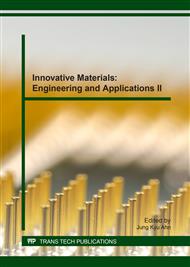p.554
p.563
p.569
p.574
p.580
p.587
p.595
p.601
p.607
Analysis of the Application of Piezoelectric Ceramic Material in the De-Icing Technique of the Aircrafts
Abstract:
The application of piezoelectric ceramic material in de-icing technique of aircrafts is presented in numerical simulation and experiment methods. Firstly, the ice properties are introduced briefly as the evaluation of device design. Then, modal simulation of the testing skin of NACA 0030 is performed to determine the position where the piezoelectric ceramics fix. The resonance frequency as the driving frequency in the experiment is calculated in harmonic analysis with the actuators bonding on the testing skin model. Moreover, piezoelectric de-icing rig is fabricated as the modeling results. It is shown that the driving frequency agrees well with the calculated resonance frequency, and the ice can be removed when the driving frequency is 1530 Hz and the driving voltage is 650 V. In addition, design factors as material properties, size of the ceramics, and excitation voltage are discussed. From the numerical calculation, the stress will vary with different piezoelectric ceramic materials and sizes of the ceramics. It will decrease with the increase of thickness of the piezoelectric ceramics, but increase linearly with the increase of the voltage. Therefore it is considerable to choose design parameters for piezoelectric de-icing systems.
Info:
Periodical:
Pages:
580-586
Citation:
Online since:
February 2017
Authors:
Price:
Сopyright:
© 2017 Trans Tech Publications Ltd. All Rights Reserved
Share:
Citation:


